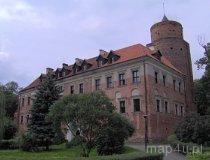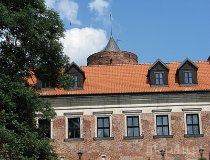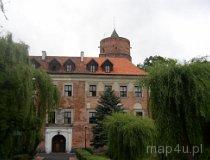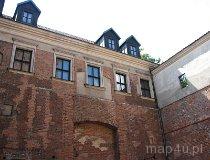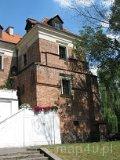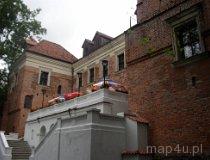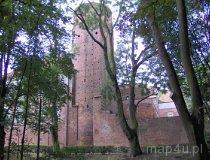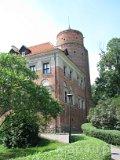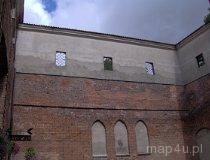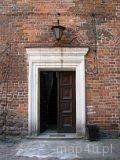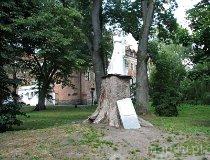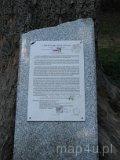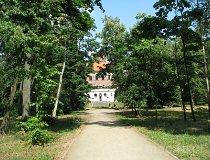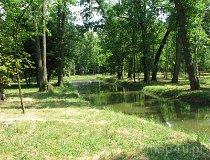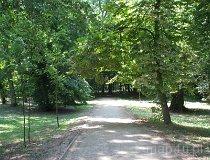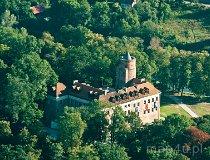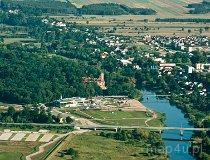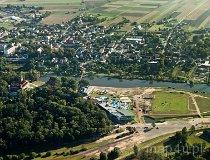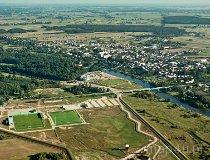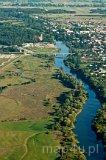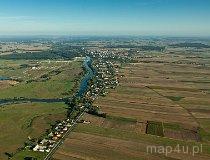The castle in Uniejów
Description
The castle is situated on an artificial mound overlooking the River Warta. There are not many historic building of this kind not only in the Łódź Voivodeship, but also in the whole country.
The oldest parts of the castle are time-worn, but some of its medieval elements survived. These include the narrow courtyard, the Gothic tower and the barrel-vaulted chapel decorated with frescos depicting St Adalbert, Jesus Christ and St Mary.
The original stronghold can be found in the middle of the current castle. It consisted of a quadrangle of walls, which was 29 m long and 23 m wide, a dwelling house adjacent to them, a chapel and a cylindrical tower, which is still noticeable. The tower was 9 m in diameter and 25 m heigh.
Visitors can also notice two 15th-century four-sided dwelling corner towers. The current L-shaped building linking the tower with the gate was constructed in 1525-1534. Inside, there was the castle chapel with polychrome decoration, fragments of which survived. The south wing of the castle was built in the 17th century. In that period the entrance gate was decorated with a baroque portal. The castle owns its present shape to the 19th-century alterations made by the Troll family, who also added the neoclassical terrace with stairs, situated on the axis of the park.
The castle is surrounded with a park covering the area of 37 ha. 60 species of trees and bushes grow there. Some of them, such as swamp cypress, Kentucky coffeetree and plane, are exotic.
In the nearby old stronghold there is now a resort built around the local thermal springs.
Date or time of building
XIV w.
Date or time of building
The 14th century
Building material
Brick and stone castle.
History
Documents dated back to 1339 mention a 12th-century wooden stronghold in Uniejów. They describe Teutonic Knights' attack in 1331. The stone castle in Uniejów was supposed to be incorporated into Casimir the Great's system of border strongholds. Built in 1350-1365, it was supposed to defend the central part of the country from attacks from the north and north west, together with Łęczyca, Sieradz and Koło. It was a purely defensive building. In 1381 it was captured by Bernard of Grabowo. In the 15th century additional fortifications were built, but they did not defend the castle against another attack. In 1492 it was defeated by Wawrzyniec Kośmider Gruszczyński of Iwanowice.
During that period the building was not only a residence, but also a library. Church archives were also kept there, since Uniejów was a meeting place of the clergy. The castle was also a prison for the infidels and disobedient priests.
Moreover, the Gniezno church kept its goods there in times of unrest. Until the 16th century, it happened nine times. During the Thirteen Years' War between the Prussian Confederation, allied with the Kingdom of Poland, and the Teutonic Order state in 1454-66, the church kept in the castle such valuable items as chasubles, chalices, monstrances and even holy relics: a hand and the head of St Adalbert.
In 1525 the castle burnt and was subsequently rebuilt in Renaissance architectural style. It gradually lost its defensive character. In the first half of the 17th century it was converted into a palace. In 1796, after the secularization conducted by the Prussian authorities, the castle was abandoned and in 1836 it was given by the tsarist government to general Karol Troll (allegedly as a reward for his part in suppressing the November Uprising). His son Aleksander settled in Uniejów, renovated the castle and redesigned the park. Members of the Troll family lived in the castle until the end of the first world war. In the interwar period it was a boarding house and a school and during the second world war it served as a storehouse for grain, coal and salt. After the renovation in 1956-1967, the building became a hotel with a restaurant.
Curious details
One of the prisoners kept in the castle was Hans Brandt, a sculptor, who was sentenced in 1485 for running away with an advance payment for carving St Adalbert's grave for the Gniezno chapel. He escaped to Prussia, but was captured and locked in prison in Uniejów, where he was forced to finish his task.
Form of legal protection
The entries in the Voivodeship Heritage Register:
- The castle in Uniejów - the castle park, registry number: A-481/222 of August 19, 1992
- The castle in Uniejów, registry number: 256/714 of October 21, 1967
Object location
The castle is situated on the left bank of the Warta River, by the road no. 72. To get there, you have to drive from Łódź in the direction of Turek. Look for the signposts. The castle is linked to the town market square by a footbridge over the river.
Accessibility
The castle serves as a conference and training centre, a hotel and a restaurant. It can be visited after consulting with the personnel. The courtyard and the park covering the area of 37 ha are freely accessible. The Great Knights' Tournament takes place in Uniejów every year during the first weekend of July.
Description of places and rooms
Object capacity: 18
Number of rooms: 9
Price range - description
Price range - from: 125.00
Price range - to: 260.00




